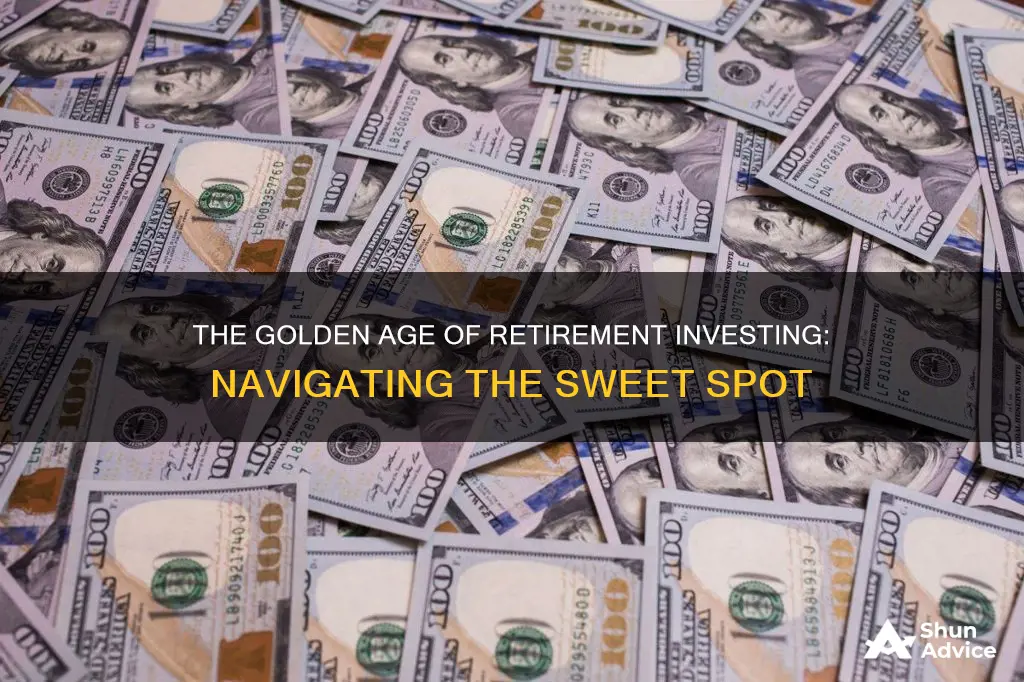
The best time to start investing for retirement is now. The earlier you start, the more time your money has to grow, and the more time you have to ride out market fluctuations. This is due to the power of compounding interest, which can significantly grow your assets over an extended period.
For example, if you start saving for retirement at 25 and contribute $3,000 per year for 10 years, your funds will have 30 years to grow before you retire at 65. Assuming 7% annual growth, your $30,000 in contributions will grow to almost $315,500 by the time you retire. However, if you start saving at 35 and contribute the same amount for 30 years, your contributions will only grow to roughly $306,000.
Therefore, the best period for retirement investing is as soon as possible, regardless of your age or financial situation.
| Characteristics | Values |
|---|---|
| When to start saving for retirement | As early as possible |
| How to start saving for retirement | Contribute to a 401(k) or similar retirement plan |
| How to balance risk and reward | Diversify your portfolio across different asset classes |
| Safest investment options for retirees | Bonds, dividend-paying stocks, CDs, and annuities |
| How to protect retirement savings from inflation | Diversify your investment portfolio with low-risk, income-generating investments |
| Tax considerations for retirees | Traditional IRAs, Roth IRAs, and 401(k)s |
| How to manage cash flow in retirement | Understand your predicted expenses and create a budget that factors in inflation and healthcare costs |
| How to manage market volatility | Diversify your assets within and across different market sectors |
What You'll Learn

The importance of starting early
Compounding interest is a powerful tool that allows you to earn interest on the interest gained on your account, creating a snowball effect that significantly increases your savings over time. The longer your money is invested, the more time it has to benefit from compounding interest, and the larger your nest egg will be when it's time to retire.
For example, let's say you start saving for retirement at 25 and contribute $3,000 per year to your 401(k) plan for 10 years. If you stop contributing at 35 and retire at 65, your funds will have 30 years to grow. Assuming 7% annual growth, your $30,000 in contributions will grow to almost $315,500 by the time you retire. On the other hand, if you wait until you're 35 to start saving and contribute $3,000 per year for 30 years, your savings will only grow to around $306,000 by the time you're 65. Even though you contributed for an extra 20 years and put in an additional $60,000, you still end up with less money due to the power of compounding interest.
Starting early also gives you the advantage of being able to invest in riskier assets, such as stocks, which tend to have higher returns. When you're younger, you have a higher tolerance for risk because you have more time to recover from any market downturns. As you get closer to retirement, it's generally recommended to adopt a more conservative investment strategy to protect your assets.
Additionally, starting early means you don't have to contribute as much each month to reach your retirement goals. If you start saving in your 20s, you may only need to put away a small amount each month, making it easier to stick to your savings plan. The longer you wait, the more you'll need to invest each month to catch up.
So, if you're thinking about saving for retirement, remember that the best time to start is now. Don't put it off until tomorrow when you can start building your nest egg today.
Invest in These 3 Things Now
You may want to see also

The power of compounding interest
The key to maximising the benefits of compounding interest is to start saving or investing as early as possible. The longer your money has to grow, the more time compounding interest has to work its magic. For example, if you save $200 a month for 35 years at a 3% interest rate, your money will grow to $148,680. However, if you save the same amount but at a 6% interest rate, your money will more than double, reaching $286,370. This demonstrates the impact of the interest rate on the power of compounding.
Compounding interest can be applied to retirement savings plans, such as a 401(k) or an Individual Retirement Account (IRA). The earlier you start contributing to these plans, the more time your contributions have to grow and benefit from compounding interest. For example, if you start saving $3,000 per year at age 25 and continue for 10 years, assuming a 7% annual growth rate, your contributions will grow to almost $315,500 by the time you retire at 65. On the other hand, if you delay saving until age 35 and contribute $3,000 per year for 30 years, your savings will only grow to approximately $306,000, despite contributing for an extra 20 years. This illustrates the power of starting early and allowing compounding interest to work in your favour.
It is important to note that while compounding interest can significantly grow your wealth over time, it is not without its risks. Market volatility, sequence risk, and the potential for negative returns or large market falls can impact the value of your investments. Therefore, it is crucial to carefully consider your investment strategy, diversify your portfolio, and regularly review and adjust it based on market conditions and your financial needs. Additionally, seeking advice from financial professionals or retirement experts can help you maximise the power of compounding interest while managing the associated risks.
By understanding the power of compounding interest and starting to save or invest as early as possible, you can harness this force to build your savings and achieve your retirement goals more quickly than with simple interest or delayed savings plans.
Home Loan vs. Investing: Where Should Your Money Go?
You may want to see also

How to manage cash flow
While there is no definitive answer to when the best period for retirement investing is, there are several strategies you can employ to manage your cash flow effectively and build a comfortable retirement fund. Here are some detailed instructions to help you with cash flow management:
- Monitor your cash flow regularly: Stay on top of your finances by reviewing your income and expenses frequently. This will help you identify any discrepancies and make necessary adjustments.
- Understand the concept of compounding interest: The earlier you start saving for retirement, the more time your money has to grow. Compounding interest occurs when your retirement fund earns interest, and this amount compounds over time, resulting in significant growth.
- Prioritize saving over expenses: While it's important to manage your current expenses, such as rent, groceries, and loans, remember that saving for retirement should also be a priority. Even if you can only save a small amount each month, starting early will make a significant difference in the long run.
- Take advantage of employer-sponsored plans: If your employer offers a retirement plan, such as a 401(k), start contributing as early as possible. You can also explore other options like an Individual Retirement Account (IRA) to maximize your savings.
- Determine your risk tolerance: As you approach retirement, consider adopting a more conservative investment strategy to protect your assets. This may include investing in lower-risk options such as corporate bonds, treasury notes, and dividend-paying stocks.
- Utilize catch-up contributions: If you started saving for retirement later in your career, take advantage of catch-up contributions to boost your retirement savings. This will help you "catch up" and maximize your retirement fund.
- Manage your portfolio risk: Investing after retirement is crucial to ensure your savings continue to grow. Focus on managing risk and preserving your capital. Consider investing in lower-risk options such as certificates of deposit, annuities, dividend-paying stocks, and bonds.
- Diversify your investments: Diversify your portfolio across different asset classes, such as stocks, bonds, real estate, and cash. This will help protect your savings from market fluctuations and provide a more stable source of income during retirement.
- Review and adjust your budget: Create a detailed budget that accounts for your predicted expenses during retirement, including inflation and healthcare costs. Regularly review and adjust your budget to ensure it aligns with your retirement goals and changing circumstances.
- Maintain liquidity: Ensure you have sufficient liquid assets to access cash when needed. This can be achieved through fixed-income investments or by periodically selling appreciated equity investments.
- Seek professional advice: Consult retirement experts or financial advisors to gain professional insights and guidance tailored to your specific needs and goals. They can assist you in making the most of your income options and navigating market fluctuations.
Retirement vs. Trading: Navigating Your Investment Portfolio
You may want to see also

Understanding market volatility
Market volatility is a statistical measure of the dispersion of returns for a given security or market index. It is often associated with big price swings, either up or down. For example, when the stock market rises and falls more than 1% over a sustained period, it is called a volatile market.
Volatility is a key factor in pricing options contracts. It represents how much an asset's prices swing around the mean price. Volatile assets are considered riskier than less volatile assets because their prices are expected to be less predictable.
There are two types of volatility:
- Implied volatility: This measures how volatile the market will be in the future. It is a key feature of options trading and is used to determine trading strategies and set prices for option contracts.
- Historical volatility: This gauges the fluctuations of underlying securities by measuring price changes over predetermined time periods. It is less prevalent than implied volatility because it isn't forward-looking.
Understanding and managing market volatility is crucial for maintaining a post-retirement portfolio. Diversifying your assets within and across different market sectors can help mitigate volatility. For example, instead of investing only in industrial companies, consider diversifying your portfolio across multiple sectors, such as energy, financials, and technology.
Additionally, it is important to regularly rebalance your asset allocation to ensure it aligns with your risk tolerance and that you are on track to meet your financial goals. As you approach retirement, adopting a more conservative investment strategy by prioritising low-risk investments is generally recommended.
While market volatility can be distressing for investors, it is important to remember that making changes to your investment plans during a crisis is rarely advisable. Instead, focus on creating a well-structured plan that aligns with your financial goals and maintain a well-diversified investment portfolio.
Smart Ways to Invest $100,000
You may want to see also

Mitigating sequence-of-return risk
Build Buffers and Adjust Withdrawals
One approach is to build buffers into your portfolio so you don't have to sell during downturns. This can be achieved by contributing larger amounts early on if possible. Additionally, consider adjusting your withdrawal strategy. While the 4% rule is a common guideline, suggesting a 4% withdrawal of the initial account value adjusted for inflation annually, it may not be suitable for all situations. Research by Wade Pfau and others suggests that a more conservative withdrawal rate of 2.5% or 3% could be considered to make the money last a lifetime. Alternatively, you can shift from a fixed withdrawal amount to withdrawing a percentage of the current account value, although this creates volatile retirement income.
Diversification and Asset Allocation
Diversifying your portfolio is a powerful tool to mitigate sequence-of-return risk. Consider diversifying into small-cap or international stocks, and increasing your equity exposure beyond 50%. Additionally, regularly review and adjust your asset allocation based on market conditions and your risk tolerance. As you near retirement, adopting a more conservative investment strategy by prioritising low-risk investments like corporate bonds, treasury notes, and dividend-paying stocks may be advisable.
Bucketing Strategy
The bucketing strategy involves separating your assets into different buckets for various time periods. This strategy helps meet short-term spending needs and reduces the impact of market downturns. For instance, holding one to two years' worth of cash reserves can provide liquidity during a market downturn, allowing your equity investments to recover.
Reverse Mortgages and Home Equity
For homeowners, tapping into home equity through a reverse mortgage or line of credit can be a strategy to generate cash flow during retirement. This approach can be particularly useful during market downturns, providing needed cash flow without selling investments. However, it's important to carefully consider the costs and risks associated with reverse mortgages and consult a trusted advisor.
Bond Laddering
Creating a bond ladder involves purchasing bonds that mature over a set number of periods. For example, buying bonds that mature in one, two, three, four, and five years can provide a secure income for the next five years, reducing the need to spend from your investment portfolio.
Pound Cost Averaging
Phasing your investments over time, such as investing a third or a sixth of your money monthly, helps reduce the risk of investing all your money just before a stock market crash. This strategy, known as pound cost averaging, allows you to invest at an average price over the phasing period, mitigating the impact of market volatility.
Forging Checks: A Risky Investment Gamble
You may want to see also
Frequently asked questions
The best time to start investing for retirement is now. The earlier you start, the less money you will need to put away each year, and the more time your money has to grow.
This depends on many things, including your lifestyle, your retirement age, and your other sources of retirement income. However, it will probably be a large amount, and that is why starting early is so important.
This depends on your lifestyle, retirement age, and other sources of retirement income. A good rule of thumb is to save enough so that you are investing more than you are spending.
There are various retirement fund options available, including stocks, mutual funds, exchange-traded funds (ETFs), and retirement accounts such as 401(k)s and IRAs.







